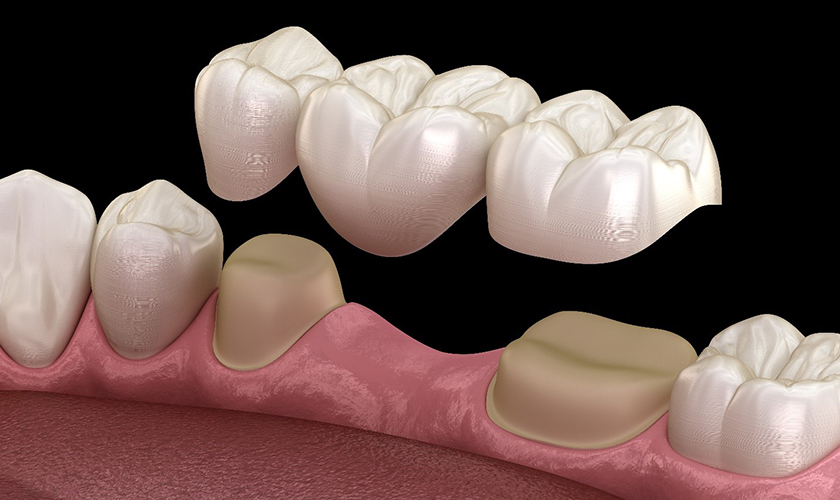
Have you ever experienced the unexpected challenge of a dental bridge coming loose or falling out?
This situation can be alarming, but knowing how to respond promptly can make a significant difference in preserving your oral health and the integrity of your dental restoration. Dental bridges play a crucial role in restoring smiles and dental function, but accidents happen, and bridges may sometimes dislodge due to various reasons, such as trauma or natural wear.
When a dental bridge falls out, taking immediate action is key to minimizing discomfort and preventing further complications. This blog will equip you with essential steps to handle this situation effectively.
Whether you’re at home or traveling, these proactive measures can help you manage the situation with confidence and ensure you receive the necessary dental care promptly. Understanding what to do when faced with a loose dental bridge empowers you to protect your oral health and maintain the functionality of your smile.
Let’s explore the proactive steps you can take to address this issue swiftly and effectively.
Step 1: Retrieve the Bridge Immediately
When a dental bridge falls out, time is of the essence. Acting quickly can help prevent further complications and increase the chances of successfully reattaching the bridge. Here’s what you need to do:
- Importance of Acting Quickly: Retrieving the bridge promptly can prevent it from getting lost or damaged, which may complicate reattachment.
- How to Safely Retrieve the Bridge: Gently pick up the bridge by holding the crowns or the solid part of the bridge. Avoid touching the pontic (false tooth) directly to prevent contamination or damage.
Step 2: Handle with Care
Handling the dislodged bridge properly is crucial to avoid additional damage and ensure its integrity for reattachment:
- Tips for Handling the Bridge: Handle the bridge delicately to avoid bending or breaking it. Use clean hands and avoid excessive force.
- Importance of Keeping the Bridge Clean: Keeping the bridge clean minimizes the risk of infection and maintains its hygiene until it can be reinserted.
Step 3: Assess the Condition
Before attempting any temporary solutions, assess the condition of the bridge and your oral health:
- Steps to Assess the Condition: Examine the bridge for any visible damage or signs of wear. Check your gums and teeth for discomfort or irritation.
- Checking for Damage or Discomfort: Look for cracks, loose components, or signs of damage on the bridge and surrounding teeth.
Step 4: Clean the Area
Maintaining oral hygiene around the dislodged bridge is essential to prevent infection and ensure proper reattachment:
- Importance of Cleaning: Clean the dislodged bridge and the surrounding teeth gently to remove debris and bacteria.
- Recommended Cleaning Techniques: Use a soft toothbrush and mild toothpaste to clean the bridge. Rinse your mouth with lukewarm water to ensure cleanliness.
Step 5: Temporary Solutions
While waiting to see your dentist, it’s essential to secure the dislodged bridge temporarily to minimize discomfort and prevent further complications:
- Temporary Measures: Use dental adhesive or temporary dental cement (available at pharmacies) to temporarily secure the bridge in place.
- Tips to Minimize Discomfort: Avoid chewing on the side with the dislodged bridge. Stick to softer foods and avoid sticky or hard substances that could dislodge the bridge further.
By following these immediate actions, you can effectively manage the situation when a dental bridge falls out. Remember, seeking professional dental care promptly is crucial to ensure the bridge is reattached correctly and your oral health is maintained.
Contacting Your Dentist
When your dental bridge falls out, it’s crucial to contact your dentist as soon as possible to ensure prompt care and restoration of your oral health:
- Importance of Prompt Contact: Timely communication with your dentist is essential to schedule an appointment promptly and prevent further complications.
Discussing Repair or Replacement Options
Your dentist will assess the condition of the dislodged bridge and discuss the best options for repair or replacement:
- Assessment of the Bridge: Your dentist will examine the bridge to determine if it can be reattached or if a replacement is necessary.
- Options for Repair: Depending on the condition of the bridge, repair may involve reattaching it using dental adhesive or temporary cement.
- Consideration of Replacement: If the bridge is damaged beyond repair or if it’s an older bridge nearing the end of its lifespan, replacement with a new bridge may be recommended.
Taking immediate action when your dental bridge falls out is crucial for minimizing discomfort and preventing further complications. By following these steps promptly, you can safeguard your oral health and ensure a swift resolution with your dentist.
